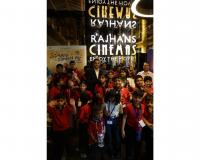Morari Bapu brings together Maharishi Valmiki’s Ramayana and Goswami Tulsidas’ Ram Charit Manas


Valmiki Nagar (Bihar) [India], June 5: Valmiki Nagar, Bihar, June 1, 2024 – Renowned spiritual guru Morari Bapu, known for his profound interpretations of the Ram Charit Manas, has emphasized the importance of building bridges, or “setus,” in a world increasingly marked by conflict. Drawing parallels from the Ramayana, Bapu illustrated how Lord Ram served as a bridge between various kings, sages, and even castes. Similarly, Bapu’s Vyas Peeth aims to bridge the Valmiki Ramayana and Goswami Tulsidas’ Ram Charit Manas.
In his ongoing discourse in Valmiki Nagar, Morari Bapu explained, “Just as Lord Ram was a setu between King Dasrath and King Janak, and between the sages Vishwamitra and Vashishtha, my efforts are to create a setu between the different narratives of the Ramayanas.” Bapu’s choice to speak on Maharishi Valmiki’s Ramayana during his 937th Katha is an attempt towards the same.
Addressing the differences between the two Ramayanas, Bapu stated, “There are several differences in narratives, but there are ‘Sat Koti Ramayana’—innumerable Ramayanas in different epochs, hence different narratives are natural.” He cited examples such as Valmiki’s portrayal of Ravan as a protector of Vedic dharma, in contrast to Tulsi Ramayana’s depiction of Ravan as a tormentor who was formerly king Pratapbhanu in his previous birth. “This can happen as different epochs can have different personalities in the same role,” he explained.

Morari Bapu also touched on the essence of Sanatana Dharma, describing it as “Nirantar Nutanta”—an ever-new freshness. He reiterated his belief that Maharishi Valmiki was reborn as Goswami Tulsidas, who wrote the Ram Charit Manas to reflect the cultural needs of his time.
The Katha event, aptly named “Manas Ramayan,” is being held from June 1 to June 9, 2024, in the scenic Valmiki Nagar near the famous Valmiki Tiger Reserve, which spans the border between India and Nepal. This location holds significant historical and spiritual relevance, being close to the Valmiki Ashram where Sita gave birth to her twin sons, Kush and Luv, and where she concluded her earthly leela.
The event features free vegetarian meals for all attendees, regardless of their participation in the Katha. It is hosted by Paren and Mayuri Shah of Baroda. The central verses chosen by Bapu for this Katha are:
nānā bhā̐ti rāma avatārā | rāmāyana sata koṭi apārā || (Various are the manifestations of Ram; the Ramayanas are innumerable.) —Balkand, Doha 33
baṁdau̐ muni pada kaṁju rāmāyana jehi̐ niramayau | sakhara sukomala maṁju doṣa rahita dūṣana sahita || (I bow to the lotus feet of the sage who composed the Ramayana, devoid of flaws and featuring the story of Dushan.) —Soratha, Balkand, Doha 14
Valmiki Nagar is a renowned tourist spot featuring a dam on the Gandak River, crucial for irrigation and hydro-electricity generation. Visitors can explore the natural beauty and serene surroundings of the Himalayan foothills, including the historic Valmiki Ashram, where Maharshi Valmiki, the author of the Ramayana, is said to have spent several years. The ashram is also marked by two temples dedicated to the sage and Sita, along with places signifying where Sita gave birth to Kush and Luv and where she entered the earth.
The Valmiki Nagar National Park and Tiger Reserve, spread across 544 square kilometers, is home to myriad wild animals and birds, with the magnificent Himalayas providing a backdrop for this calm wild land.
If you have any objection to this press release content, kindly contact pr.error.rectification@gmail.com to notify us. We will respond and rectify the situation in the next 24 hours.






